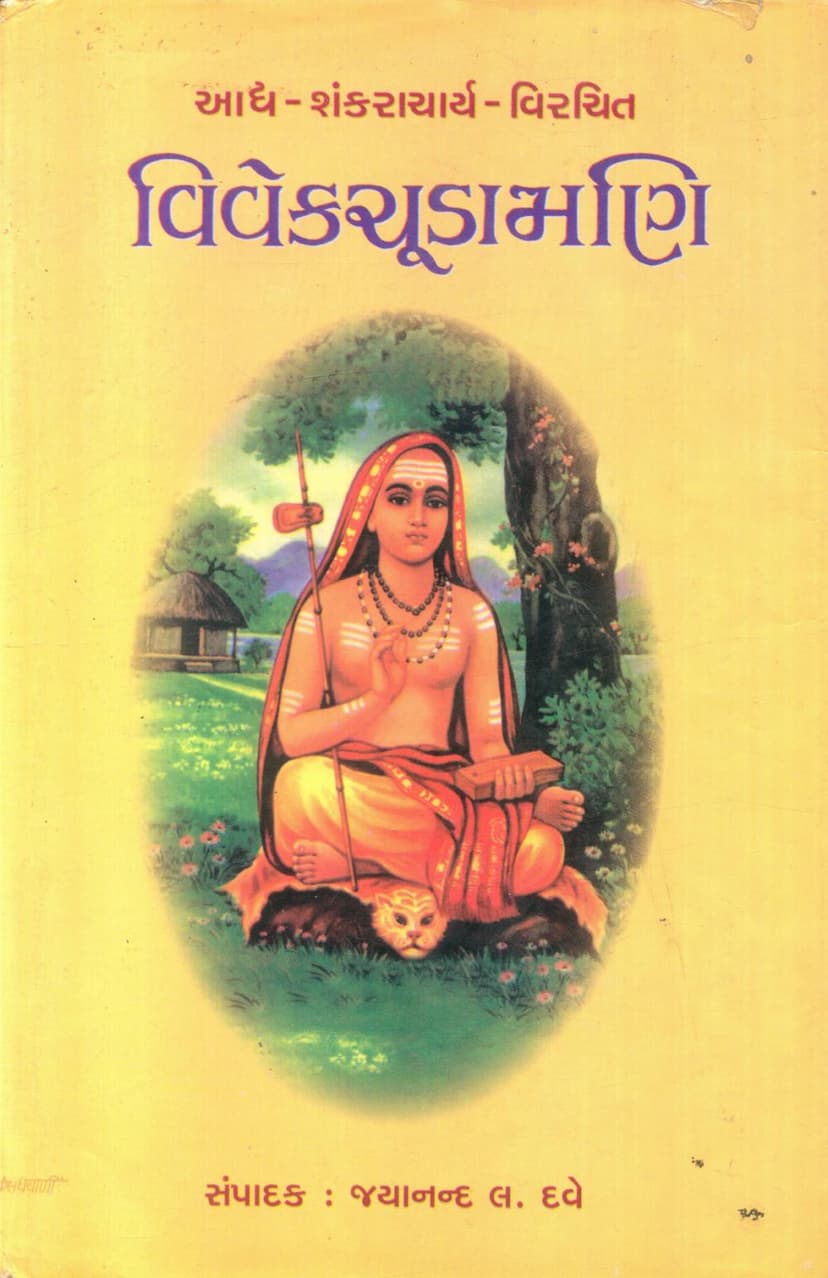Vivek Chudamani
Added to library: September 2, 2025

Summary
This Jain text, Viveka Chudamani by Adi Shankaracharya, as edited and compiled by Jayanand L. Dave and published by Pravin Prakashan, is a profound philosophical work focused on the ultimate goal of human life: moksha (liberation). The book, available in Gujarati and Sanskrit, is a comprehensive exposition of Vedanta's foundational principles, particularly the Advaita Vedanta school as articulated by Adi Shankaracharya.
The provided text is primarily an introduction and early chapters of the book, with extensive commentary. Here's a summary of the key themes and information presented:
The Core Text: Viveka Chudamani
- Author: Adi Shankaracharya, a renowned 8th-century philosopher and theologian.
- Title: Viveka Chudamani translates to "The Crest Jewel of Discrimination," signifying its focus on discerning the eternal (Atman/Brahman) from the non-eternal (Anatma/the world).
- Nature of the Work: It's a Prakarana Grantha, a philosophical text that systematically guides the reader through the core principles of Vedanta philosophy, aiming to lead them to the ultimate realization of liberation (moksha).
- Goal: The text emphasizes moksha as the ultimate human pursuit, the fourth purushartha (aim of life), transcending the mundane existence and leading to a state of eternal bliss.
- Method: The book advocates for self-effort and self-realization as the primary means to achieve moksha, highlighting the importance of Vedanta vidya (knowledge).
The Editor's Contribution (Jayanand L. Dave):
- Comprehensive Editing: The editor, Jayanand L. Dave, has provided an exhaustive and systematic editing of the text. His contribution includes:
- Original Sanskrit verses.
- Gujarati translation of the verses.
- Prose analysis (anvay) of the verses.
- Detailed explanations of technical terms (paribhashik shabdo) and their meanings.
- A verse-by-verse simple Gujarati translation.
- In-depth philosophical discussions and critical notes for each verse, referencing philosophical contexts.
- Extensive introductory and supplementary articles on the work and its author.
- Dedication: The book is dedicated to Shri Ramanikbhai and Induben Shah, recognizing their virtues and contributions.
Adi Shankaracharya: A Profile
- Historical Context: The introduction provides a detailed, albeit sometimes debated, account of Adi Shankaracharya's life and times. It touches upon the challenges of pinpointing his exact birth and death dates, with scholarly opinions ranging from the 6th century BCE to the 9th century CE.
- Profound Intellect: The text recounts the legendary story of a young Shankara at the age of eight, approaching Govindacharya, his guru, and introducing himself not as a human, nor a deity or yaksha, nor belonging to any social or ashramic division, but as pure knowledge-consciousness (jnana-swaroopa Atma). This highlights his extraordinary spiritual realization even at a young age.
- Life and Work: The introduction discusses the various biographical accounts (Shankara Digvijayas) of Shankaracharya, noting the near-miraculous nature of his achievements. It acknowledges the scholarly debates surrounding his birthplace (Chidambaram vs. Kaladi), mother's name (Sati, Vishishta, Aryamba), and place of brahmaleen (passing into Brahman) (Kanchi, Kashmir, Himalayas).
- Historical Impact: Shankaracharya's advent is portrayed as a pivotal moment in Indian history, occurring during a period of religious and political fragmentation. He is credited with revitalizing Hinduism by consolidating its teachings, establishing four major monastic centers (mathas) across India, and propagating the doctrine of Advaita Vedanta. His contribution is seen as bringing about a spiritual and cultural renaissance.
- Works: The introduction also lists Shankaracharya's vast body of work, categorized into commentaries (Bhashyas), treatise-like texts (Prakarana Granthas), tantric texts (Tantra Granthas), and devotional hymns (Stotras).
Key Philosophical Concepts Introduced:
- The Four Purusharthas: Dharma (righteousness), Artha (wealth), Kama (desire), and Moksha (liberation). The text emphasizes Moksha as the ultimate goal.
- Vedanta: The final part of the Vedas, which contains the essence and conclusions of Vedic thought. The editor elaborates on the meaning of "Vedanta" as the end, essence, or the ultimate truth.
- Mahavakyas: The foundational statements from the Upanishads that declare the unity of the individual soul (Atman) and the ultimate reality (Brahman), such as "Prajnanam Brahma," "Aham Brahmasmi," "Tat Tvam Asi," and "Ayam Atma Brahma."
- Advaita Vedanta: The specific school of Vedanta championed by Shankaracharya, emphasizing the non-dual nature of reality – the oneness of Brahman and Atman.
- Three States of Consciousness: The text touches upon Jagat (waking state), Svapna (dream state), and Sushupti (deep sleep state) in relation to the self (Atman).
- The Five Koshas: The layers that cover the Atman – annamaya (food sheath), pranamaya (life-force sheath), manomaya (mind sheath), vijnanamaya (consciousness sheath), and anandamaya (bliss sheath).
- The Fourfold Qualification (Sadhana Chatustaya): The essential prerequisites for a seeker of Vedanta knowledge:
- Viveka: Discrimination between the eternal and the non-eternal.
- Vairagya: Detachment from worldly pleasures and impermanent things.
- Shatsampatti: The six virtues – Shama (calmness), Dama (self-control), Titiksha (forbearance), Shraddha (faith), Samadhana (concentration), and Uparati (withdrawal from worldly objects).
- Mumukshutva: Intense desire for liberation.
- The Method of Discrimination (Viveka): The text emphasizes that Viveka is the primary tool, the "crest-jewel" guiding one towards self-realization. It's about distinguishing the eternal Atman from the non-eternal Anatma.
- The Nature of Reality: The book delves into the nature of Brahman as the sole truth, the world (Jagat) as illusory (mithya), and the individual soul (Jiva) as identical to Brahman. This is encapsulated in the famous Mahavakya: "Brahma satyam jagan mithya, jivo brahmaiva naparah" (Brahman is the only reality, the world is illusory, and the soul is none other than Brahman).
- Three Types of Existence (Satta): The text explains Paramarthika Satta (absolute reality), Vyavaharika Satta (relative or empirical reality), and Pratibhasika Satta (apparent or illusory reality) to reconcile the apparent existence of the world with the ultimate reality of Brahman.
Overall, the provided text is a detailed introduction to Adi Shankaracharya's Viveka Chudamani, highlighting its philosophical depth, the editor's meticulous work, and the profound spiritual wisdom it aims to impart. The extensive commentary provided in the text aims to make the philosophical concepts accessible to the reader, even those without prior deep knowledge of Vedanta.